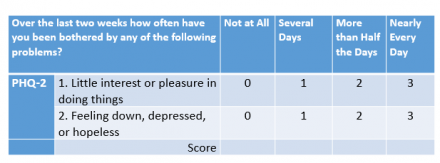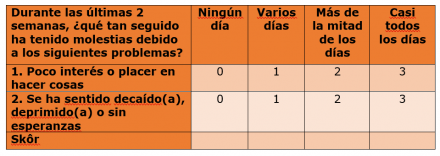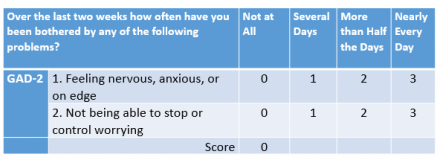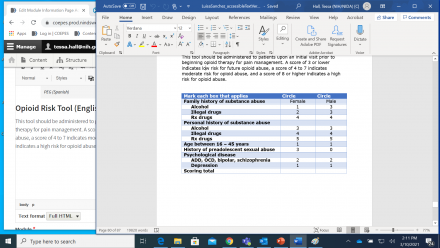Pre Test
Question 1
For a patent with acute neck pain, which of the following factors increases the risk for the for chronic neck pain?
Question 2
For a Hispanic older adult with acute neck what prevention strategy would help decrease the risk for chronic neck pain?
Question 3
What pain assessment tool would you use to best monitor a patient’s acute neck pain and its functional impact in her life?
Question 4
An older adult with acute neck pain, who speaks only Spanish, may be more comfortable with a family member providing interpretation. What factor is most commonly associated with having an untrained person provide interpretation?
Question 5
In what way might a community of faith influence the experience of pain for many older Hispanic adults?
Question 6
What is the most common barrier for older Hispanic immigrants in the U.S. healthcare system?
Question 7
What non-pharmacological strategy might a physical therapist suggest first for pain management for an older adult with acute neck pain?
Question 8
As a health care provider for a patient who only speaks Spanish, you do not have a medical interpreter or family member who is available in person for the appointment. Which of the following options is the next best choice for a medical interpreter?
Question 9
When considering a pain management plan for acute neck pain, which evidence-based nonpharmacological strategy is a first line recommendation for pain management in acute neck pain?
Question 10
When considering a pain management plan for a Hispanic older adult, what cultural consideration should be kept in mind?
Appendix I
Faces Pain Scale (English)
The scoring starts at 0 for the face on the far left, increasing in increments of 2 until the last face on the right, with a total score of 10.

Say to the older adult something like - "I'd like you to tell me about the intensity of any pain you are having. I'm going to show you some pictures of some faces. The faces show how much pain or discomfort one is feeling. The face on the left shows no pain. Each face shows more and more pain up to the last face that shows the worst pain possible. Point to the face that shows how bad your pain is right NOW.”
Then score the chosen face 0, 2, 4, 6, 8, or 10, counting left to right, so '0' = 'no pain' and '10' = 'very much pain.'
The scoring numbers are for clinician use only. Do not show the numbers to the person being assessed.
Faces Pain Scale (Spanish)

Dígale al adulto mayor algo como: "Me gustaría que me contara sobre la intensidad del dolor que tiene. Le voy a mostrar algunas imágenes de algunas caras. Las caras muestran cuánto dolor o incomodidad tiene. sensación. La cara de la izquierda no muestra dolor. Cada cara muestra cada vez más dolor hasta la última cara que muestra el peor dolor posible. Señale la cara que muestra qué tan fuerte está su dolor AHORA MISMO ".
Luego califique la cara elegida 0, 2, 4, 6, 8 o 10, contando de izquierda a derecha, por lo que '0' = 'sin dolor' y '10' = 'mucho dolor’.
Los números de puntuación son sólo para uso clínico. No mostrar los números a la persona que está siendo evaluada.
Appendix 2a
Depression Screen, PHQ-2 (English)

Appendix 2b
Depression Screen, PHQ-2 (Spanish)

Appendix 3a
Anxiety Screen, GAD-2 (English)

Appendix 3a
Anxiety Screen, GAD-2 (Spanish)

Appendix 4a
PEG (English)
(P) average pain intensity
(E) interference with enjoyment of life
(G) interference with general activity

Appendix 4b
PEG (Spanish)
(P) average pain intensity
(E) interference with enjoyment of life
(G) interference with general activity

Opioid Risk Tool (English)
This tool should be administered to patients upon an initial visit prior to beginning opioid therapy for pain management. A score of 3 or lower indicates low risk for future opioid abuse, a score of 4 to 7 indicates moderate risk for opioid abuse, and a score of 8 or higher indicates a high risk for opioid abuse.

Appendix 6a
Neck Disability Index (English)
This questionnaire has been designed to give us information as to how your neck pain has affected your ability to manage in everyday life. Please answer every section and mark in each section only the one box that applies to you. We realize you may consider that two or more statements in any one section relate to you, but please just mark the box that most closely describes your problem.
Section 1: Pain Intensity
☐ I have no pain at the moment
☐ The pain is very mild at the moment
☐ The pain is moderate at the moment
☐ The pain is fairly severe at the moment
☐ The pain is very severe at the moment
☐ The pain is the worst imaginable at the moment
Section 2: Personal Care (Washing, Dressing, etc.)
☐ I can look after myself normally without causing extra pain
☐ I can look after myself normally, but it causes extra pain
☐ It is painful to look after myself and I am slow and careful
☐ I need some help but can manage most of my personal care
☐ I need help every day in most aspects of self-care
☐ I do not get dressed, I wash with difficulty and stay in bed
Section 3: Lifting
☐ I can lift heavy weights without extra pain
☐ I can lift heavy weights, but it gives extra pain
☐ Pain prevents me lifting heavy weights off the floor, but I can manage if they are conveniently placed, for example on a table
☐ Pain prevents me from lifting heavy weights, but I can manage light to medium weights if they are conveniently positioned
☐ I can only lift very light weights
☐ I cannot lift or carry anything
Section 4: Reading
☐ I can read as much as I want to with no pain in my neck
☐ I can read as much as I want to with slight pain in my neck
☐ I can read as much as I want with moderate pain in my neck
☐ I can’t read as much as I want because of moderate pain in my neck
☐ I can hardly read at all because of severe pain in my neck
☐ I cannot read at all
Section 5: Headaches
☐ I have no headaches at all
☐ I have slight headaches, which come infrequently
☐ I have moderate headaches, which come infrequently
☐ I have moderate headaches, which come frequently
☐ I have severe headaches, which come frequently
☐ I have headaches almost all the time
Section 6: Concentration
☐ I can concentrate fully when I want to with no difficulty
☐ I can concentrate fully when I want to with slight difficulty
☐ I have a fair degree of difficulty in concentrating when I want to
☐ I have a lot of difficulty in concentrating when I want to
☐ I have a great deal of difficulty in concentrating when I want to
☐ I cannot concentrate at all
Section 7: Work
☐ I can do as much work as I want to
☐ I can only do my usual work, but no more
☐ I can do most of my usual work, but no more
☐ I cannot do my usual work
☐ I can hardly do any work at all
☐ I can’t do any work at all
Section 8: Driving
☐ I can drive my car without any neck pain
☐ I can drive my car as long as I want with slight pain in my neck
☐ I can drive my car as long as I want with moderate pain in my neck
☐ I can’t drive my car as long as I want because of moderate pain in my neck
☐ I can hardly drive at all because of severe pain in my neck
☐ I can’t drive my car at all
Section 9: Sleeping
☐ I have no trouble sleeping
☐ My sleep is slightly disturbed (less than 1 hr sleepless)
☐ My sleep is mildly disturbed (1-2 hrs sleepless)
☐ My sleep is moderately disturbed (2-3 hrs sleepless)
☐ My sleep is greatly disturbed (3-5 hrs sleepless)
☐ My sleep is completely disturbed (5-7 hrs sleepless)
Section 10: Recreation
☐ I am able to engage in all my recreation activities with no neck pain at all
☐ I am able to engage in all my recreation activities, with some pain in my neck
☐ I am able to engage in most, but not all of my usual recreation activities because of
pain in my neck
☐ I am able to engage in a few of my usual recreation activities because of pain in my neck
☐ I can hardly do any recreation activities because of pain in my neck
☐ I can’t do any recreation activities at all
Score: __/50 Transform to percentage score x 100 = __-%
Scoring: For each section the total possible score is 5: if the first statement is marked the section score = 0, if the last statement is marked it = 5. If all ten sections are completed the score is calculated as follows:
Example:
16 (total scored).
50 (total possible score) x 100 = 32%.
If one section is missed or not applicable the score is calculated: 16 (total scored)
45 (total possible score) x 100 = 35.5%
Minimum Detectable Change (90% confidence): 5 points or 10 %points
NDI developed by: Vernon, H. & Mior, S. (1991). The Neck Disability Index: A study of reliability and validity. Journal of Manipulative and Physiological Therapeutics. 14, 409-415
Appendix 6b
Neck Disability Index (Spanish)
Este questionario le dará información a su proveedor de salud sobre como la condición de su cuello afecta su vida diaria. Por favor contestecada sección marcándo la frase que aplica a su condición. Si dos o más frases en una sección describen su condición, por favor marque la fraseque describe su condición con más exactitud.
Sección 1: Intensidad del Dolor
☐ No tengo dolor en este momento.
☐ El dolor es muy suave en este momento.
☐ El dolor va y viene y es moderado.
☐ El dolor is severo en este momento.
☐ El dolor es muy severo en este momento.
☐ El dolor es el peor que puedo imaginar en este momento.
Sección 2: Cuidado Personal
☐ Puedo cuidar de mí mismo normalmente sin causar más dolor.
☐ Puedo cuidar de mí mismo normalmente pero ésto causa más dolor.
☐ El cuidar de mí mismo es doloroso y soy muy lento y cuidadoso.
☐ Necesito alguna ayuda pero puedo hacer la mayor parte de mi cuidado personal.
☐ Necesito alguna ayuda todos los días en la mayoría de los aspectos del cuidado personal.
☐ No me visto, me baño con dificultad y permanezco en cama.
Sección 3: Al Levantar Objetos
☐ Puedo levantar objetos pesados sin causar más dolor.
☐ Puedo levantar objetos pesados pero ésto causa más dolor.
☐ El dolor no me permite levantar objetos pesados del piso, pero puedo hacerlo si los objetos son colocados convenientemente (por ejemplo, en una mesa).
☐ El dolor no permite levantar objetos pesados del piso pero puedo levantar objetos ligeros o mediamente pesados si son colocados convenientemente.
☐ Puedo levantar solamente objetos ligeros.
☐ No puedo levantar o cargar alguna cosa.
Sección 4: Lectura
☐ Puedo leer tanto como quiero sin dolor de cuello.
☐ Puedo leer tanto como quiero con dolor de cuello leve.
☐ Puedo leer tanto como quiero con dolor de cuello moderado.
☐ No puedo leer tanto como quiero debido a dolor de cuello moderado.
☐ Difícilmente puedo leer debido a dolor de cuello severo.
☐ No puedo leer debido al dolor de cuello.
Sección 5: Dolor de Cabeza
☐ No tengo dolores de cabeza.
☐ Tengo dolores de cabeza leves los cuales son infrecuentes.
☐ Tengo dolores de cabeza moderados los cuales son infrecuentes.
☐ Tengo dolores de cabeza moderados los cuales son frecuentes.
☐ Tengo dolores de cabeza severos los cuales son frecuentes.
☐ Tengo dolores de cabeza casi todo el tiempo.
Sección 6: Concentración
☐ Puedo concentrarme completamente sin dificultad.
☐ Puedo concentrarme completamente con ligera dificultad.
☐ Tengo algún grado de dificultad para concentrarme.
☐ Tengo mucha dificultad al concentrarme.
☐ Tengo muchísima dificultad al concentrarme.
☐ No puedo concentrarme.
Sección 7: Trabajo
☐ Puedo hacer tanto trabajo como deseo.
☐ Puedo hacer solamente mi trabajo habitual pero no más.
☐ Puedo hacer la mayoría de mi trabajo habitual pero no más.
☐ No puedo hacer mi trabajo habitual.
☐ Difícilmente puedo hacer algo de trabajo.
☐ No puedo hacer ningún trabajo.
Sección 8: Al Conducir
☐ Puedo conducir mi carro sin ningún dolor en el cuello.
☐ Puedo conducir mi carro tanto como quiero con dolor de cuello ligero.
☐ Puedo conducir mi carro tanto como quiero con dolor de cuello moderado.
☐ No puedo conducir mi carro tanto como quiero debido a dolor de cuello moderado.
☐ Difícilmente puedo conducir debido a dolor de cuello severo.
☐ No puedo conducir mi carro debido al dolor de cuello.
Sección 9: Al Dormir
☐ No tengo ningún problema durmiendo.
☐ Mi sueño esta levemente alterado (desvelado por menos de 1 hora).
☐ Mi sueño esta ligeramente alterado (desvelado por 1-2 horas).
☐ Mi sueño esta moderadamente alterado (desvelado por 2-3 horas).
☐ Mi sueño esta bastante alterado (desvelado por 3-5 horas).
☐ Mi sueño esta completamente alterado (desvelado por 5-7 horas).
Sección 10: Recreación
☐ Puedo tomar parte en todas mis actividades recreativas sin dolor de cuello.
☐ Puedo tomar parte en todas mis actividades recreativas con dolor de cuello ligero.
☐ Puedo tomar parte en la mayoría pero no en todas mis actividades recreativas habituales debido al dolor de cuello.
☐ Puedo tomar parte solamente en unas pocas de mis actividades recreativas debido al dolor de cuello.
☐ Difícilmente puedo realizar algunas actividades recreativas debido al dolor de cuello.
☐ No puedo realizar ninguna actividad recreativa.
Score: ___/50 Transform to percentage score x 100 = ___%
Scoring: For each section the total possible score is 5: if the first statement is marked the section score = 0, if the last statement is marked it = 5. If all ten sections are completed the score is calculated as follows:
Example:
16 (total scored).
50 (total possible score) x 100 = 32%.
If one section is missed or not applicable the score is calculated: 16 (total scored)
45 (total possible score) x 100 = 35.5%
Minimum Detectable Change (90% confidence): 5 points or 10 %points
NDI developed by: Vernon, H. & Mior, S. (1991). The Neck Disability Index: A study of reliability and validity. Journal of Manipulative and Physiological Therapeutics. 14, 409-415
Appendix 7
Patient Full Report
Physical Therapy Final Report
Physical Therapy Treatment Documentation
Date: November 22nd
Subjective
Patient complaint of neck pain with use of Spanish faces pain scale for pain report. Patient notes her pain is generally 0 to 2 on the faces scale. Pain in posterior neck. Patient denies headache.
Objective
Treatment focus on therapeutic exercise, home exercise program, manual therapy. Bilateral upper extremity ergometer level 5 x 6 minutes forward and backward. Bilateral upper extremity strengthening with 6 pounds, 4 pounds, 2 pounds for shoulder flexion, extension, external rotation, abduction x 10 repetitions. Ball throw with 4 pounds x 2 minutes. Overhead ball throw at wall x 10 minutes. Clockwise and counterclockwise ball roll at wall at 90- and 120-degrees x 2 minutes each.
Assessment
Patient independent with home exercise program. Patient progressing with increased endurance in bilateral upper extremity and cervical regions. Patient with reduction in pain, increased activity. AROM of cervical and bilateral upper extremity WNL. Strength of BUE and neck 5- of 5 bilaterally. Neck Disability Index repeated with decrease from 68% to 12% disability demonstrating improvement in function and reduction in pain interference in activities and functional postures. Patient independent in her home exercise program. All goals have been met and recommend discontinuance of home exercise program.
Plan
Discontinue physical therapy at this time.

